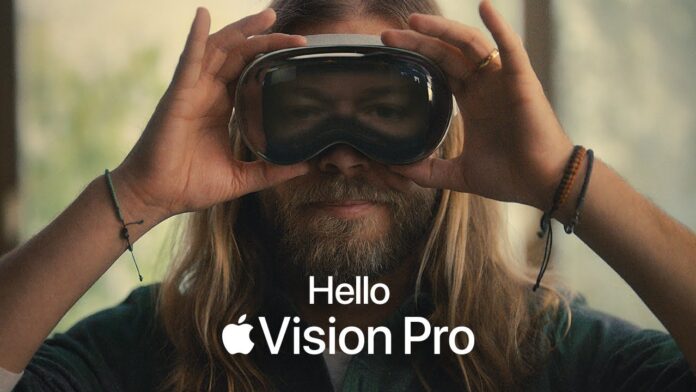Apple’s new mixed reality headset, Vision Pro, arrives in the UK at £3,499, promising immersive experiences but facing scepticism over widespread adoption
Apple’s Vision Pro headset, a groundbreaking device that merges the real world with digital content, will be available in the UK starting this Friday. Priced at £3,499, the “spatial computing” device offers control through eye movements, hand gestures, and voice commands. The Vision Pro, which debuted in the US earlier this year, had subsequent releases in China, Hong Kong, Japan, and Singapore in late June. It marks Apple’s significant entry into the mixed-reality headset market.
Essentially a wearable computer, the Vision Pro overlays apps and other digital content onto the real world. Apple has highlighted its potential as a personal cinema screen or a virtual gallery for photos and videos. The headset features built-in speakers and an adjustable headband, with a wire connecting the device to a battery pack that can be carried in a pocket, allowing users mobility while wearing it.
Apple CEO Tim Cook expressed excitement about the international rollout, stating, “The enthusiasm for Apple Vision Pro has been extraordinary, and we are thrilled to introduce the magic of spatial computing to more customers around the world. We can’t wait for more people to see the impossible become possible, whether working and collaborating with an infinite canvas for apps, reliving treasured memories in three dimensions, watching TV shows and movies in a one-of-a-kind personal cinema, or enjoying brand-new spatial experiences that defy imagination.”
Despite the fanfare, virtual, mixed, or augmented reality headsets have yet to gain widespread acceptance among the general public. Industry experts remain cautious about Apple’s foray into this market. Leo Gebbie, principal analyst at CCS Insight, noted, “The Apple Vision Pro is undoubtedly a headline draw in the world of virtual and augmented reality, but it’s fair to say that its expansion into other geographies comes with less fanfare than expected. After a wave of early enthusiasm for the spatial computing device, sales for the Vision Pro appeared to dampen down, and it feels as though Apple is struggling to clearly articulate the value of the device to buyers – especially given the £3,500 price tag.”
Gebbie added, “The Vision Pro remains a stunning piece of design and is easily one of the most impressive pieces of technology I’ve ever used. There’s also no doubt that Apple’s presence provides a halo effect for the spatial computing industry, and with Samsung also committed to launching a headset, there’s strong momentum in the segment. But Apple is running into the same fundamental problem that has vexed rivals in the world of virtual reality, which is providing a strong pipeline of use cases and applications. Until buyers on the high street are given a clear reason why they might want to put on a headset on a daily basis, it’s a tricky sell.”
Analysis:
Political:
Apple’s release of the Vision Pro in the UK signifies a strategic move in global technology markets. As tech companies increasingly compete for dominance in the virtual and augmented reality space, Apple’s entry highlights the importance of innovation and market penetration in maintaining technological leadership. The UK’s market is a crucial test for Apple’s mixed reality ambitions, reflecting the broader geopolitical dynamics of technology competition.
Social:
The Vision Pro’s introduction raises questions about the societal impact of immersive technologies. While promising enhanced entertainment and productivity experiences, the device’s high cost and niche appeal may limit its accessibility. This disparity could widen the digital divide, as only a segment of the population might afford and adopt such advanced technology. Moreover, the integration of digital content into daily life prompts discussions about screen time, virtual interactions, and the balance between digital and real-world experiences.
Racial:
Apple’s Vision Pro launch may influence the representation of diverse groups in virtual spaces. As augmented and virtual reality platforms evolve, ensuring inclusive and representative content becomes crucial. The Vision Pro’s potential to create immersive environments offers an opportunity to address racial and cultural representation in digital media. By promoting diverse narratives and experiences, Apple could leverage Vision Pro to foster a more inclusive digital landscape.
Gender:
The Vision Pro’s user interface, controlled by eyes, hands, and voice, may have implications for gender inclusivity in technology. Ensuring that the device’s features are accessible and intuitive for all users, regardless of gender, is essential. Additionally, the marketing and content available on the Vision Pro should reflect gender diversity to appeal to a broader audience. Apple’s efforts in this regard could set a precedent for gender-sensitive design in future technological innovations.
Economical:
The Vision Pro’s high price point highlights economic considerations in the adoption of cutting-edge technology. At £3,499, the headset may be seen as a luxury item, accessible primarily to affluent consumers. This pricing strategy could limit widespread adoption, impacting Apple’s market reach. However, the Vision Pro’s success could drive down costs over time, making such technology more affordable. Additionally, the device’s potential applications in various industries, from entertainment to remote work, could spur economic growth and create new market opportunities.
